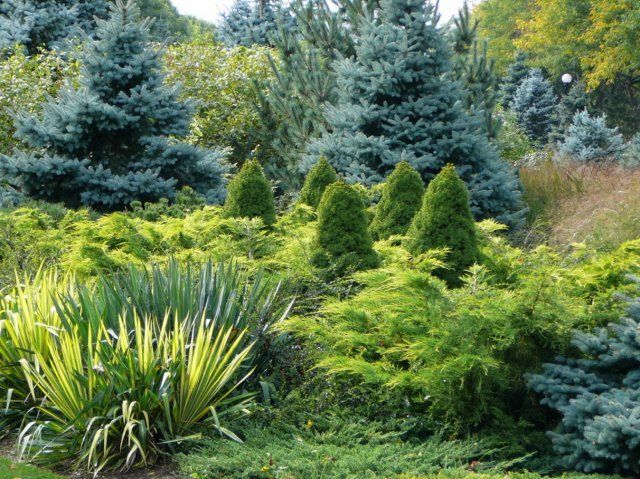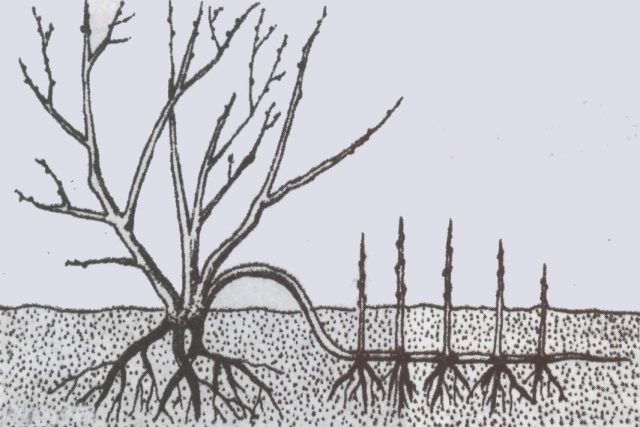Content
One of the most popular ornamental ground cover plants is Blue Chip juniper. It thickly covers the soil with its shoots, forming a velvety, soft, green covering. At different times of the year, the coniferous leaves of this crop in the form of soft needles have different colors. Designers choose this variety of juniper for beautifying slopes, rockeries, and creating coniferous compositions.
Description of juniper horizontal Blue Chip
Juniper of this species is a coniferous evergreen plant that belongs to the Cypress family. You can see it in the wild in the countries of the northern hemisphere (USA, UK, Canada); cultivated juniper takes root in almost any climate. Grows well on plains, mountain slopes, and on the banks of small reservoirs.
Description of juniper bluechip: the shrub has dense dense needles of ash-gray or blue color. In autumn it turns purple, in spring it turns bright green. Long shoots, more than 1 m, growing horizontally, densely cover the soil. The stems are densely covered with long, soft needles (1 to 5 mm in length), which exude a characteristic aroma. The narrow leaves in the form of needles are not smooth, but scaly, which creates a velvety texture of the crown of the bush. This description of Blue Chip juniper fully corresponds to the following photo:
Blue Chip is valued not only for its high decorative qualities, but also for its ability to aromatize and purify the air. The culture takes root well in cities with high air pollution. In autumn, berries appear on Blue Chip juniper bushes in the form of small, blue, spherical fruits. They rarely appear on ornamental shrubs. They are considered medicinal and used in folk medicine.
Dimensions of Juniper Blue Chip
This is a small shrub whose shoots spread along the ground. It reaches a height of about half a meter. The crown of the juniper juniperushorizontalisbluechip grows up to 1.5 m in diameter. As they grow, coniferous shoots evenly cover the soil surface with a gray-blue carpet. The bush spreads mainly horizontally and practically does not grow in height.
Annual growth of Blue Chip juniper
Shoots of blue bush can grow up to 10 cm per year. To obtain a dense, decorative, vegetative covering of the area, up to a dozen or more seedlings of this crop are planted.
Frost resistance of juniper horizontal Blue Chip
The homeland of this plant is North America and Canada, it is a frost-resistant shrub. Only young seedlings need shelter for the winter in the first year after planting.
Juniper Blue Chip in landscape design
The shrub is used in coniferous compositions with thujas, spruce trees, bush species of juniper, and in flower beds to emphasize the beauty of flowering plants. Coniferous mixborders have a great advantage over other decorative compositions: they look presentable all year round.
Horizontal juniper Blue Chip looks great in compositions using large decorative stones (rockeries). Glades, hills, and flower beds covered with a thick juniper carpet look impressive, especially near bodies of water. Horizontal juniper is planted along garden paths and walls of buildings in the form of a border. Such a low fence looks good all year round and does not lose its shape. Gray-blue greenery looks good against gray walls.
Planting and caring for horizontal juniper Blue Chip
In order for an ornamental plant to have a beautiful appearance and retain its qualities for a long time, you should choose the right place for planting it. This crop is sun-loving and will not grow in the shade. Juniper seedlings can be purchased at any ornamental plant nursery. When buying Blue Chip juniper, you should pay attention to the condition of the roots and shoots.
It should be a seedling with a well-developed root system and several shoots of the current code, densely covered with needles. The presence of yellow or white spots on the needles is unacceptable. The shoots should be flexible and not overdried. The root of the seedling is kept closed in a plastic pot or container until planting.Do not allow the earthen ball to dry out around the root system.
Preparing seedlings and planting area
To plant Blue Chip juniper in the garden, choose an area free from other plants, well lit by the sun. You can root the culture in partial shade. The soil chosen is moderately moist and acidic. Excess moisture or salinization of the soil is detrimental to the crop. To avoid this, a fairly thick layer of drainage is laid out in the planting hole. Bushes are planted at a distance of 2 m from each other. This will allow the horizontal Blue Chip juniper to grow in accordance with the diameter of the crown.
Landing rules
Planting is done in the spring, at the end of March or at the beginning of April, and also in the fall, while the weather remains warm. The planting hole is made in dimensions 2 times larger than the size of the juniper root. A layer of expanded clay is laid at the bottom of the pit. It will serve as a drainage base. Afterwards, the hole is half filled with a nutritious soil mixture: turf, peat, sand. These ingredients are taken in equal parts. If the soils are acidic, there is no need to add peat.
Subsequent planting technology:
- The hole filled with soil is filled with water.
- As soon as the liquid is absorbed, the root of the plant is lowered into the planting hole, as carefully as possible, trying to keep the earthen lump intact.
- Afterwards, the rhizome is covered with fluffy soil and compacted.
Watering and fertilizing
In summer, the plant is watered once a week regularly, in spring and autumn - twice a month. It is impossible to fill juniper with water. Watering should be moderate, no more than 10 liters per bush. The Blue Chip juniper is watered for the first time immediately after planting or transplanting.
Fertilizing is carried out once in summer, autumn and spring. These can be nitrogen, phosphate and organic fertilizers. It is good to use special fertilizers for coniferous crops with the addition of potassium for these purposes.
Mulching and loosening
Before and after watering, the soil must be loosened. This will relieve the juniper roots from stagnant moisture and increase air exchange. Loosening is carried out carefully, trying not to damage the roots of the bush.
As soon as the water is well absorbed after watering, the tree trunk circle is covered under a layer (5 cm) of spruce, sawdust, and pine needles. This will preserve life-giving moisture at the root of the plant and reduce the number of waterings. If the soil is not alkaline enough, mulching is done with pine bark.
Pruning juniper Blue Chip
This procedure is carried out in early spring. They simply remove old dried branches, freeing up space for the growth of young shoots. The tips of plants that have frozen over the winter should also be cut off.
Preparing for winter
The horizontal juniper plant Blue Chip is covered for the winter only in the first year after planting. The tree trunk circle is mulched with a thick layer of sawdust (at least 10 cm), the crown is covered with branches of coniferous trees. Juniper Blue Chip, older than 1 year, is not afraid of frost in winter and does not need shelter.
Reproduction of juniper horizontalis Blue Chip
To propagate this crop, layering or cuttings are used. Rooting by layering is a simple way to propagate juniper. Strong, healthy shoots are selected, bent to the ground and secured with staples. The soil is first loosened, fertilized, and a little sand is added. After about six months, the shoot will take root. After this, it is separated from the mother plant and planted separately.
Propagation by cuttings is a more complex method. In early spring, before the buds open, strong shoots are selected and cut into small branches 12 cm in length. Then, using a knife, one edge is cleared of bark and the cutting is lowered into a mixture of sand and peat. The seedling is watered regularly. The room temperature should not fall below + 20 Cᵒ. As soon as the sprout takes root, it is rooted into the ground in the warm season.
Diseases and pests of horizontal juniper Blue Chip
This ornamental crop is susceptible to attacks by garden pests: aphids, scale insects, and spider mites. To prevent their appearance, juniper bushes are sprayed with insecticides in early spring and again in summer.
Blue Chip juniper can also be affected by root rot and rust. If the plant begins to wither, dry out, and various spots appear on the surface of the shoots, I treat the bush with fungicides. An effective remedy for fungal diseases is Bordeaux mixture. After treating the crown of the plant with chemicals, fertilizers are applied to the roots. This will strengthen the culture after illness.
Conclusion
Blue Chip juniper is an unpretentious ornamental crop that is suitable for growing in any climate. The shrub tolerates drought and frost well. This juniper does not require special care.It looks good in all seasons, even in winter it can decorate the garden. Its high decorative qualities have been awarded many awards at international exhibitions of plant crops used in landscape design.
Reviews
The horizontal juniper Blue Chip has received only positive reviews from connoisseurs of ornamental plants. Plant growers like it for its unpretentiousness and beautiful appearance even in winter.














